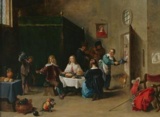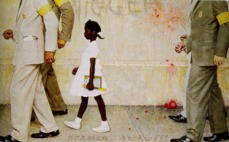

Genre and history painting are each types of narrative art. While genre paintings depict events of an everyday sort, history paintings depict famous events.
Modernists largely rejected narrative art in the 1950s and 1960s, though it has returned strongly since then, with artists embracing several means of presentation viewed by modernists as theatrical, and therefore inappropriate to the purity of art. These include video and performance art.
Narrative may refer to a textual element, either part of or accompanying a work. For instance, photographer Duane Michals (American, contemporary) adds written texts to his series of photographs.
Examples:

Greece, Melian, Plaque with the return of Odysseus, c.
460-450 BCE,
terra cotta, height
7 3/8 inches (18.72 cm), Metropolitan Museum of Art, NY. See
Greek art
and plaque.

Georges de La Tour (French, 1593-1652), The Fortune Teller, probably 1630s, oil on canvas,
40 1/8 x 48 5/8 inches (101.9 x 123.5 cm), Metropolitan Museum
of Art, NY. (On the Met's page, you can enlarge any detail.)
See Baroque.

David Teniers, the Younger (Flemish, 1610-1690),
The
Prodigal Son, c. 1650-1700, oil
on canvas, Minneapolis
Institute of Arts.

Francisco José de Goya y Lucientes
(Spanish, 1746-1828), Don Manuel Osorio Manrique de Zuñiga (1784-1792),
possibly 1790s, oil on
canvas, 50 x 40 inches
(127 x 101.6 cm), Metropolitan Museum of Art, NY. (On the Met's
page, you can enlarge any detail.) See Romanticism.
Théodore Géricault (French, 1791-1824), The Raft of the Medusa, 1819, oil on canvas, 4.91 x 7.16 m, Louvre. Géricault pictures a real-life drama of 149 shipwrecked sailors from the frigate "Medusa", abandoned for twelve days on a raft off the Senegalese coast. He chose to depict the moment on July 17, 1816 when the 15 survivors were overcome with despair as the "Argus", the ship that eventually was to rescue them, sailed off.
Sir Edwin Landseer (English, 1802-1873),
The Traveled Monkey, 1827, oil
on panel, width
56 cm, Guildhall Library and Guildhall Art Gallery, London. The
narrative is
taken from the book Fables by English author John Gay.
See English art.

Eastman Johnson (American, 1824-1906), The Old Stagecoach, 1871, oil
on canvas, Milwaukee Art
Museum, WI.
Eastman Johnson, What the Shell Says (What the Sea Says), 1875, oil on paperboard, 21 7/8 x 16 3/4 inches (53.7 x 41.3 cm), Fine Arts Museums of San Francisco, CA.

Winslow Homer (American, 1836-1910), The Gulf Stream, 1899, oil
on canvas, 28 1/8 x 49
1/8 inches (71.4 x 124.8 cm), Metropolitan Museum of Art, NY.
A young black man is alone in a boat on the high seas, unable
to sail because the mast of his boat has been lost. While the
waters around him roil with sharks and patches of blood, a ship
on the horizon holds out the possibility of rescue.

John Sloan (American, 1871-1951), Ludlow, Colorado (Class War in Colorado), drawing for an illustration in The New York Call, April 25, 1914,
1914, lithographic crayon on wove paper, Hood Museum of Art, Dartmouth College, NH. See Ashcan School and The Eight.

Norman Rockwell (American, 1894-1978), The
Problem We All Live With, published in Look, January
14, 1964, oil on canvas,
Arts International, Chicago, IL. See connoisseur,
illustration,
and Realism.
Paul Cadmus (American, 1904-1999), Sailors and Floosies, 1938, oil and tempera on panel, 25 x 39 1/2 inches (63.5 x 100.3 cm), Whitney Museum of American Art, NY.
Jacob Lawrence (American, 1917-), Paper Boats (Paper Sailboats), 1949, tempera on gessoed panel, 17 7/8 x 23 7/8 inches, Sheldon Memorial Art Gallery and Sculpture Garden, U of Nebraska, Lincoln. See Harlem Renaissance.

Mark Tansey (American, 1949-), Forward Retreat, 1986, oil
on canvas, 94 x 116 inches,
Broad Art Foundation. See monochrome.
Also see allegory, postmodernism, and theater.
https://inform.quest/_art